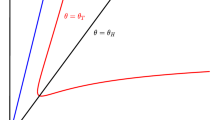Abstract
In this paper, we study the positive steady states of a prey-predator model with diffusion throughout and a non-monotone conversion rate under the homogeneous Dirichlet boundary condition. We obtain some results of the existence and non-existence of positive steady states. The stability and uniqueness of positive steady states are also discussed.
Similar content being viewed by others
References
Blat, J., Brown, K. J.: Global bifurcation on positive solutions in some systems of elliptic equations. SIAM J. Math. Anal., 17, 1339–1353 (1986)
Casal, A., Eilbeck, J. C., López–Gómez, J.: Existence and uniqueness of coexistence states for a prey– predator model with diffusion. Diff. Integral Equns., 7(2), 411–439 (1994)
Du, Y. H., Lou, Y.: Some uniqueness and exact multiplicity results for a predator–prey model. Trans. Amer. Math. Soc., 349(6), 2442–2475 (1997)
Pang, P. Y. H., Wang, M. X.: Qualitative analysis of a ratio–dependent predator–prey system with diffusion. Proc. Roy. Soc. Edinburgh A, 133(4), 919–942 (2003)
Du, Y. H., Lou, Y.: S–shaped global bifurcation curve and Hopf bifurcation of positive solutions to a predator–prey model. J. Diff. Equns., 144, 390–440 (1998)
Freedman, H. I.,Wolkowicz, G. S. K.: Predator–prey systems with group defense: The paradox of enrichment revisited. Bull. Math. Biol., 57, 493–508 (1986)
Mischaikow, K., Wolkowicz, G. S. K.: A predator–prey system involving group defence: A connection matrix approch. Nonlinear Analysis, 14, 955–969 (1990)
Pang, P. Y. H., Wang, M. X.: Non–constant positive steady states of a predator–prey system with nonmonotonic functional response and diffusion. Proc. London Math. Soc., 88(1), 135–157 (2004)
Wang, M. X.: Stationary patterns of strongly coupled prey–predator models. J. Math. Anal. Appl., 292(2), 484–505 (2004)
Wang, M. X.: Stationary patterns for a prey–predator model with prey–dependent and ratio–dependent functional responses and diffusion. Physica D, 196, 172–192 (2004)
Wolkowicz, G. S. K.: Bifurcation analysis of a predator–prey system involving group defense. SIAM J. Appl. Math., 48, 592–606 (1988)
Murray, J. D.: Mathematical Biology, second edition, Springer–Verlag, Berlin, 1993
Okubo, A.: Diffusion and Ecological Problem: Mathematical Models, Springer–Verlag, Berlin, New York, 1980
Ruan, W., Feng, W.: On the fixed point index and multiple steady states of reaction–diffusion systems. Diff. and Integral Equns., 8, 371–391 (1995)
Mimura, M., Nishiura, Y.: Pattern formation in coupled reaction–diffusion systems. Japan J. Indust. Appl. Math., 12(3), 385–424 (1995)
Ni, W. M.: Diffusion, cross–diffusion and their spike–layer steady states. Notices Amer. Math. Soc., 45(1), 9–18 (1998)
Wang, M. X.: Non–constant positive steady states of the Sel’kov model. J. Diff. Equns., 190(2), 600–620 (2003)
Yamada, Y.: Stability of steady states for prey–predator diffusion equations with homogeneous Dirichlet conditions. SIAM J. Math. Anal., 21, 327–345 (1990)
Alves, C. O., De Figueiredo, D. G.: Nonvariational elliptic systems. Discrete Contin. Dynam. Systems, 8, 289–302 (2002)
Amann, H.: Fixed point equations and nonlinear eigenvalue problems in ordered Banach spaces. SIAM Review, 18, 620–709 (1976)
Dancer, E. N.: On the indices of fixed ponits of mappings in cones and applications. J. Math. Anal. Appl., 91, 131–151 (1983)
Dancer, E. N., Du, Y. L.: Effects of certain degeneracies in the predator–prey model. SIAM J. Math. Anal., 34, 292–314 (2002)
Delgado, M., López–Gómez, J.: On the symbiotic Lotka–Volterra model with diffusion and transport effects. J. Diff. Equns., 160, 175–262 (2000)
De Figueiredo, D. G., Yang, J.: A priori bounds for positive solutions of a non–variational elliptic system. Comm. Partial Diff. Equns., 26, 2305–2321 (2001)
Gui, C. F., Lou, Y.: Uniqueness and nonuniqueness of coexistence states in the Lotka–Volterra competition model. Comm. Pure Appl. Math., XLVII, 1571–1594 (1994)
Li, L.: Coexistence theorems of steady–states for predator–prey interacting systems. Trans. Amer. Math. Soc., 305, 143–166 (1988)
Lou, Y.: Necessary and sufficient condition for the existence of positive solutions of certain cooperative system. Nonlinear Analysis, 26, 1079–1095 (1996)
Wang, M. X.: Nonlinear Partial Differential Equations of Parabolic Type (in Chinese), Science Press, Beijing, 1993
Hei, L. J., Wu, J. H.: Existence and Stability of Positive Solutions for an Elliptic Cooperative System. Acta Mathematica Sinica, English Series, 21(5), 1113–1120 (2005)
Crandall, M. G., Rabinowitz, P. H.: Bifurcation from simple eigenvalues. J. Funct. Anal., 8, 321–340 (1971)
Rabinowitz, P. H.: Some global results for nonlinear eigenvalue problems. J. Funct. Anal., 7, 487–513 (1971)
Nirenberg, L.: Topics in nonlinear functional analysis, American Mathematical Society, Providence, RI, 2001
Crandall, M. G., Rabinowitz, P. H.: Bifurcation, perturbation of simple eigenvalues, and linearized stability. Arch. Rational Mech. Anal., 52, 161–180 (1973)
Kato, K.: Perturbation Theory for Linear Operator, Springer–Verlag, New York, 1966
López–Gómez, J., Pardo, R.: Existence and uniqueness of coexistence states for the predator–prey Lotka– Volterra model with diffusion on intervals. Diff. Integral Equns., 6, 1025–1031 (1993)
Protter, M. H., Weinberger, H. F.: Maximum Principle in Differential Equations, Englewoods Cliffs, Prentice–Hall, N. J., 1967
Author information
Authors and Affiliations
Corresponding author
Additional information
This work is supported by the National Natural Science Foundation of China 10471022, and the Ministry of Education of China Science and Technology Major Projects Grant 104090. The work of R. Peng is also supported by the Foundation of Excellent Doctoral Dissertation of Southeast University YBJJ0405
Rights and permissions
About this article
Cite this article
Peng, R., Wang, M.X. & CHEN, W.Y. Positive Steady States of a Prey-predator Model with Diffusion and Non-monotone Conversion Rate. Acta Math Sinica 23, 749–760 (2007). https://doi.org/10.1007/s10114-005-0789-9
Received:
Accepted:
Published:
Issue Date:
DOI: https://doi.org/10.1007/s10114-005-0789-9




